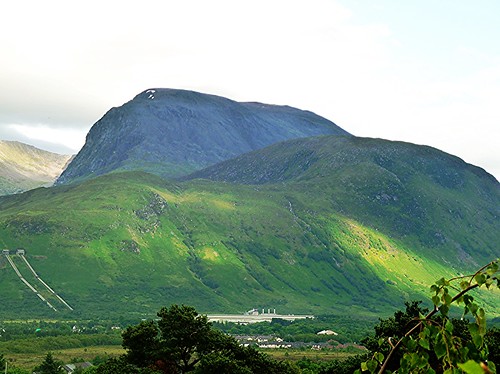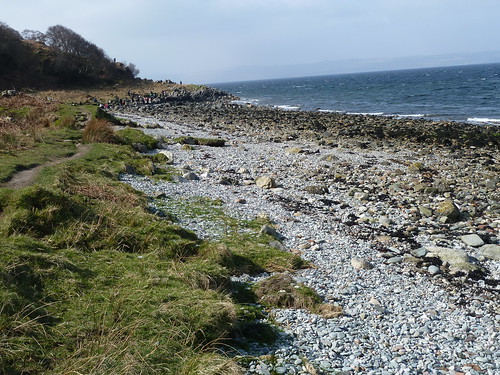Scotland's Geology
(Image above is a capture of Ben Nevis (4413 feet) Britain's tallest mountain near Fort William in the Highlands region. This mountain is of volcanic origin and dates back to the Devonian period of about 400 million years ago.)
Over the past 500 million years the land which now comprises Scotland has drifted from a position well south of the equator up across the equator to its current position about 56 degrees north, on roughly the same latitude as Labrador and Moscow. This long journey entailed exposure to submersion by oceans, desert conditions, tropical rain-forests, ice sheets and a physical join (collision) with England & Wales all of which has impacted on landscapes and geology. The approximate chronology is as follows:
- 500m years ago (Ordovican Period): Scotland and England both in southern hemisphere and separated by the very wide Iapetus Ocean.
- 410 m years ago (Silurian Period): Scotland unites with England and Wales at a position close to/connected with North America. The ‘join’ between England and Scotland is parallel with Hadrian’s Wall. The physical act of joining England and Scotland creates a high mountain range, possibly comparable with today’s Himalayas but which has since been substantially eroded. At time of the join the lands were located about 10 degrees south of the equator. Prior to the joining the land which became Scotland was a series of terranes which subsequently joined together to form a single land mass. The Highland Boundary fault featuring Conic Hill at Loch Lomond is an example of a terrane boundary.
View N.W. from Conic Hill
- 290m-360m years ago ( Carboniferous Period): Scotland is close to equator and landscape covered with tropical vegetation. During this period the Campsie Fells and Gargunnock Hills were formed by lava flows. Volcanic activity created Arthur’s Seat and the volcanic plug on which Edinburgh Castle sits. Decomposing organic matter formed the genesis of Scotland’s extensive coal reserves at this time.
Edinburgh Castle
- 250m- 290m years ago ( Permian Period) : Desert conditions prevailed resulting in accumulations of red sandstone.
- 135m-205m years ago (Jurassic Period): Initially most of Scotland was flooded by rising sea levels but the water later subsided allowing the land to be recolonised by flora and fauna.
- 65m-135m years ago (Cretaceous Period): At end of this period the North Atlantic Ocean was formed by earth movements resulting in extensive volcanic activity over a period of about 5.0m years which included Ailsa Craig and Skye. From thereon Scotland and North America progressively drifted apart.
- 65m-2.4m years ago (Tertiary Period): A humid climate, slightly warmer than today’s prevailed, a period coinciding with weathering of rocks.
- 2.4m -10,000 years ago (Quaternary): This was the Ice Age when a succession of glaciations moulded the landscape into its present shapes. The weight of ice caused the land to be lowered. At this time sea levels were also lower. However, the melt reversed these processes causing creation of ‘raised beaches’.
All of the above features combine to make Scotland a haven for geologists. Indeed, Dr. James Hutton (1726-1797) who was active during the ‘Enlightenment’ period in Edinburgh is recognised as the father of modern geology. His theories were supported by research on the Isle of Arran and elsewhere.
Geology students at Hutton's Unconformity on Isle of Arran.
© Nigel P Cole/Catswhiskerstours Limited










Comments
Post a Comment